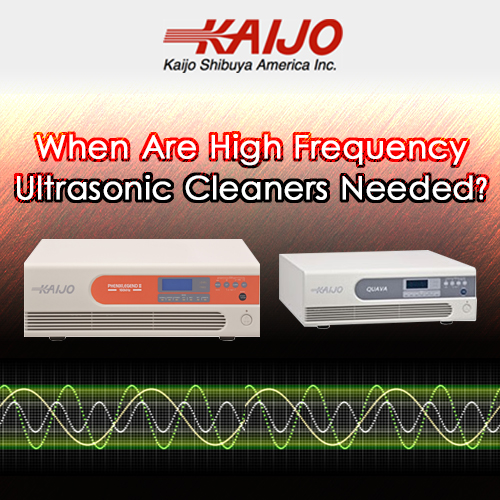When Are High Frequency Ultrasonic Cleaners Needed?
November 20, 2019
 High frequency ultrasonic cleaners are needed when the parts to be cleaned are delicate and easily damaged. Ultrasonic cleaning systems use the scrubbing action of microscopic cavitation bubbles to clean dirt and contaminants from the surfaces of parts. Low frequency systems generate large bubbles that deliver robust cleaning while high frequencies produce smaller bubbles and gentler cleaning. Parts likely to suffer damage from the action of the large bubbles have to be cleaned using high frequency ultrasonic cleaners.
High frequency ultrasonic cleaners are needed when the parts to be cleaned are delicate and easily damaged. Ultrasonic cleaning systems use the scrubbing action of microscopic cavitation bubbles to clean dirt and contaminants from the surfaces of parts. Low frequency systems generate large bubbles that deliver robust cleaning while high frequencies produce smaller bubbles and gentler cleaning. Parts likely to suffer damage from the action of the large bubbles have to be cleaned using high frequency ultrasonic cleaners.
How Cavitation Bubbles Can Damage Parts
In ultrasonic cleaning systems, the ultrasonic frequency generator produces an electrical signal that the ultrasonic transducer converts to sound waves in the cleaning solution. Cavitation bubbles form in the troughs of the sound waves and collapse in the peaks. When they collapse, the bubbles create tiny high-energy jets of cleaning solution. If the bubbles are near the surface of a part to be cleaned, the jets hit the part surface and dislodge any surface contaminants that might be there.
The energy of the jets depends on the size of the bubbles. Large bubbles from low frequency ultrasonic systems produce powerful jets that can remove heavy contamination but also remove material from delicate parts. The small bubbles of the high frequency systems create weaker jets. These jets don’t clean as fast as the jets of the lower frequency systems but they also are too weak to cause damage to parts.
Low Frequency Systems Can Cause Pitting in Soft Materials
Low ultrasonic frequencies can be used with many robust parts that are heavily contaminated with carbon, oil or grease deposits. Engine parts, stainless steel parts and machined parts made from materials with hard surfaces can be cleaned quickly at ultrasonic frequencies below 40 kHz. Parts made from materials with soft surfaces will often suffer damage at those frequencies. The high-energy jets will start by removing the surface dirt but may also remove some of the underlying material. Small pits in materials such as aluminum may result. When higher frequencies of around 100 kHz are used, the jets are not powerful enough to remove any aluminum and the pitting effect disappears.
High-Energy Jets Can Damage Part Structures
Ultrasonic cleaning is used to clean parts with complicated structures such as printed circuit boards. If the frequency used is too low and the jets from the cavitation bubbles are too energetic, tiny structural elements such as conductors, solder joints or processor connections could be broken. The key is to use a frequency high enough to avoid damage to delicate structures but low enough to clean rapidly and completely.
The Coating or Plating of Parts Can Be Eaten Away
Many parts to be cleaned such as hard disk media, flat panel glass and coated lenses are made from materials with hard surfaces but are treated with delicate coatings that are essential for their functions. When cleaning these parts with ultrasonic cleaning systems, high frequencies have to be used to preserve the integrity of the coating. Frequencies over 100 kHz deliver gentle cleaning that does not attack the coatings while removing contaminants that negatively impact the coated parts and.
Kaijo Can Help Select the Right Frequency
As a leading manufacturer of ultrasonic cleaning equipment, Kaijo can recommend the appropriate frequency for customer applications. Based on Kaijo’s experience in the field of ultrasonic cleaning systems and the in house expertise gained from manufacturing their own systems, the company can select the right frequency and ensure that it is high enough to avoid any damage to delicate parts. Kaijo offers free consultations and can follow up their recommendations with proposals from their complete line of ultrasonic equipment, ensuring that their high frequency ultrasonic cleaners deliver superior cleaning performance.





